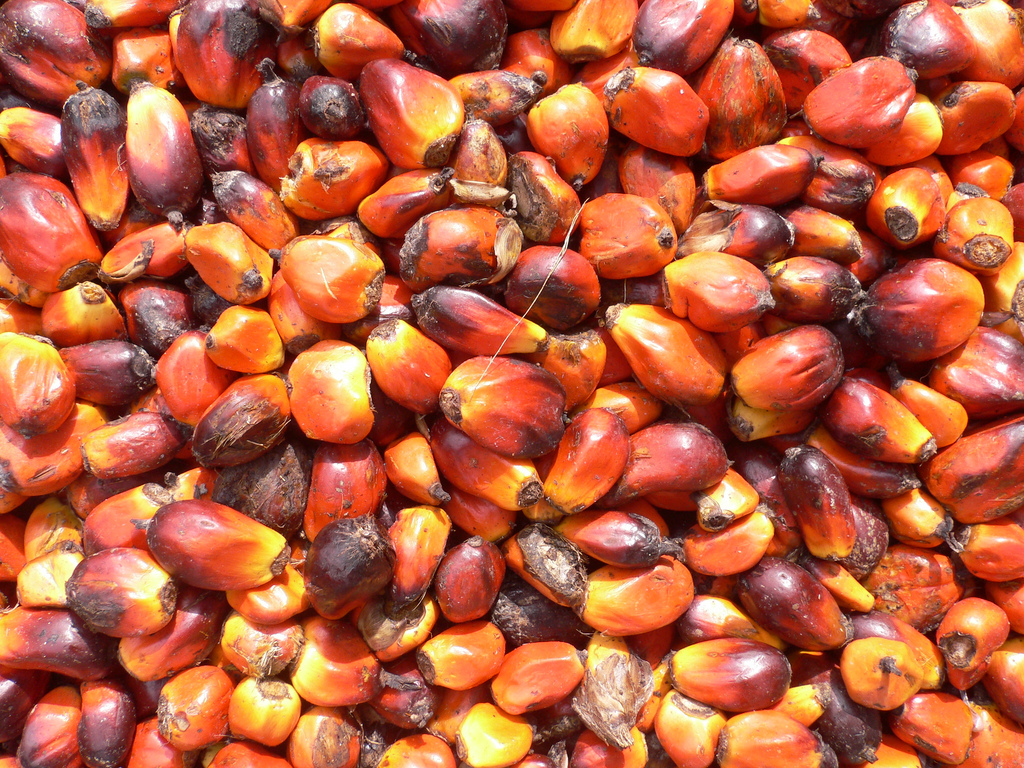Price wars: an oil palm saga in Ghana

By Fred Dzanku, William Quarmine and Gertrude Dzifa Torvikey
Image: ‘Jukwa Village and Palm Oil Production, Ghana,’ oneVillage Initiative (CC BY-NC-ND 2.0)
The grip of the ‘Big Two’ over Ghana’s oil palm processing industry has been loosened by the entrance of a third player, touting a novel and ‘farmer-inclusive’ business model. However, short-term shake-ups don’t always lead to the long-term change they set out to achieve.
In 1988, only one large-scale oil palm processor, Norpalm Ghana Ltd (NORPALM), operated in the oil palm-rich enclave of Western Ghana – until, in 2004, NORPALM was joined by Benso Oil Palm Plantation Ltd (BOPP). Since then, these two companies have gradually increased their market share, by offering price incentives to consolidate their market positions, particularly during periods of price volatility. While the two companies have always provisionally competed for palm fruit from farmers in the oil palm rich region, minimal price competition has led onlookers to accusations of collusion.
Enter player three
In 2013, however, B-BOVID – a medium-scale palm fruit processor – arrived on the scene, proclaiming farmer-inclusiveness in the oil palm industry, from farm to processing, with its widely-dispersed mantra: “We are here for the welfare of the farmers.” The only question was: how were they going to achieve this mission given the dominance of the ‘Big Two?’ Both BOPP and NORPALM run their own plantations employing hundreds of contract and outgrower farmers. B-BOVID, on the other hand, lacked any contractual arrangements with farmers; instead, it introduced a ‘passbook’ system allowing farmers and contractors to keep records of their transactions with B-BOVID – the incentive here being access for farmers to secure loans from B-VODID or B-BOVID-linked financial institutions. B-BOVID then implemented a strategy called the ‘price-sharing model’ (PSM). Farmers who subscribe to the PSM were to become shareholders of B-BOVID, and any profits earned from processing the palm fruit were to be shared as dividends between B-BOVID and subscribed farmers.
To signal their intent and breathe life into their widely-announced mission, in 2014, B-BOVID raised the farm-gate price of fresh palm fruit bunches in the enclave by 22%, initiating a ferocious price war with the Big Two. In addition, they paid a premium to farmers who supplied palm fruit with a higher oil content. The buzz created around this first significant price variation of its kind helped to established B-BOVID as a third and alternative force in the south-western oil palm region, attracting ever increasing numbers of farmers to their model. Taking advantage of the depth of their collective pockets, NORPALM and BOPP went on the counter-offensive, raising the palm fruit unit price by twice that of B-BOVID. Inevitably, financial constraints crippled B-BOVID’s ability to continue the price war with the Big Two, until B-BOVID were paying lower prices for palm fruit than NORPALM and BOPP.
Farmers win?
Interestingly, many farmers continued to sell their produce to B-BOVID, even after the Big Two outcompeted them for purchasing prices. Evoking the sense of empowerment that B-BOVID gave to producer, one farmer stated that “Before B-BOVID came, contractors were cheating us. B-BOVID deals directly with farmers regardless of the size of their farms and the quantity of produce. This is why we prefer selling to them.”
Without a doubt, the price war influenced the way oil palm-producing households participated in the market. First, the presence of B-BOVID provided many farmers with an additional market outlet for their oil palm harvest. Indeed, while the larger processing companies would not buy less than 1 t of produce, B-BOVID would purchase any quantity offered by sellers – a relief for those suffering a poor harvest, or hoping to sell oil palm fruit in the lean season. Second, these farming households were given the opportunity to sell directly to a processing plant, thus eliminating intermediaries. And third, thanks to the quality premium paid by B-BOVID, farmers could divide their produce by quality, selling different quality fruit to different markets.
The price war thus broadened the opportunities for farmers to commercialise. Rising farm-gate prices increased direct access to processors and differential pricing led to one definitive outcome – higher revenues. The effects of B-BOVID’s entry into the oil palm market and the resultant price competition can be said to have been generally positive.
Short-changed
However, the problem with price wars like the one initiated by B-BOVID is that they are often short-lived. In this case specifically, farmers who jumped on the price hikes and committed to B-BOVID became the eventual losers. When NORPALM and BOPP raised their prices above an affordable threshold for B-BOVID, contractual commitments to the latter meant that farmers could not immediately take advantage of the new prices offered by the Big Two. Not only did the losing farmers then receive relatively lower prices, but any hopes for a price-sharing model to take hold in the long-term were dashed.
So what lessons can we take from price wars characterised by spikes in buyer-determined farm-gate prices? In the short run, while price hikes last, farmers may gain from higher gross margins. However, questions remain over the sustainability of price hikes in opening routes for agricultural commercialisation for farm households. The case of Ghana’s oil palm rich Western region has shown that incentive-rich mechanisms – such as varying commercialization arrangements (i.e., nucleus farm scheme, out-grower scheme and a combination of both) – provide a more sustainable basis for boosting agricultural commercialisation.
